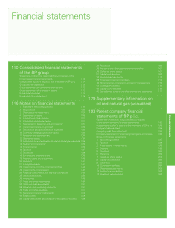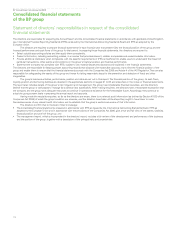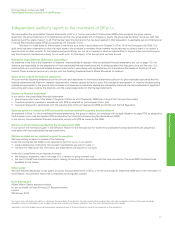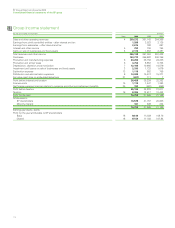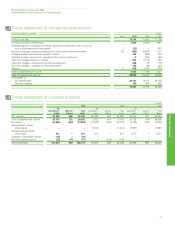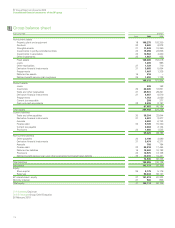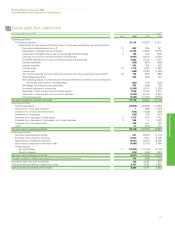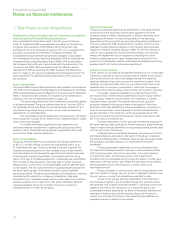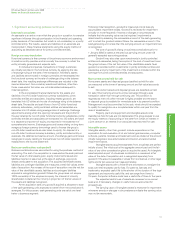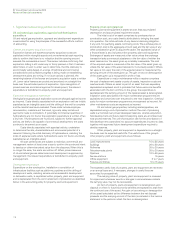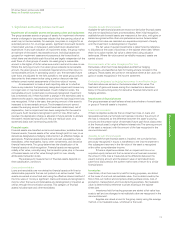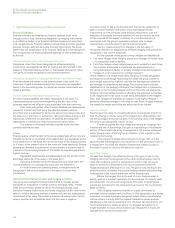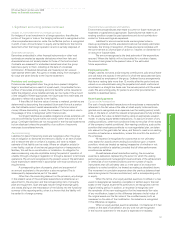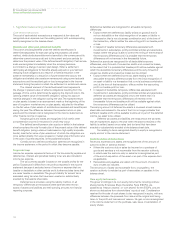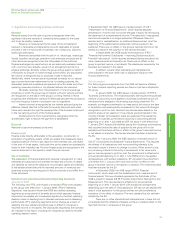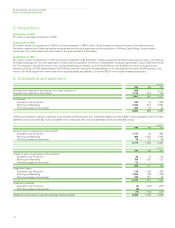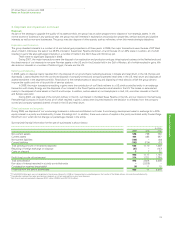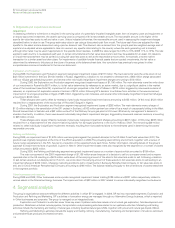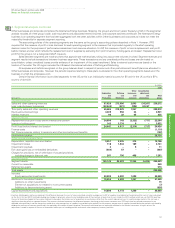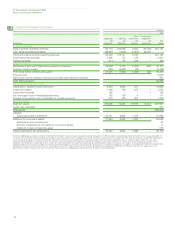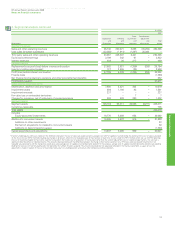BP 2009 Annual Report Download - page 121
Download and view the complete annual report
Please find page 121 of the 2009 BP annual report below. You can navigate through the pages in the report by either clicking on the pages listed below, or by using the keyword search tool below to find specific information within the annual report.
1. Significant accounting policies continued
Impairment of intangible assets and property, plant and equipment
The group assesses assets or groups of assets for impairment whenever
events or changes in circumstances indicate that the carrying value of an
asset may not be recoverable, for example, low prices or margins for an
extended period or, for oil and gas assets, significant downward revisions
of estimated volumes or increases in estimated future development
expenditure. If any such indication of impairment exists, the group makes
an estimate of the asset’s recoverable amount. Individual assets are
grouped for impairment assessment purposes at the lowest level at
which there are identifiable cash flows that are largely independent of the
cash flows of other groups of assets. An asset group’s recoverable
amount is the higher of its fair value less costs to sell and its value in use.
Where the carrying amount of an asset group exceeds its recoverable
amount, the asset group is considered impaired and is written down to
its recoverable amount. In assessing value in use, the estimated future
cash flows are adjusted for the risks specific to the asset group and are
discounted to their present value using a pre-tax discount rate that
reflects current market assessments of the time value of money.
An assessment is made at each reporting date as to whether
there is any indication that previously recognized impairment losses may
no longer exist or may have decreased. If such indication exists, the
recoverable amount is estimated. A previously recognized impairment
loss is reversed only if there has been a change in the estimates used to
determine the asset’s recoverable amount since the last impairment loss
was recognized. If that is the case, the carrying amount of the asset is
increased to its recoverable amount. That increased amount cannot
exceed the carrying amount that would have been determined, net of
depreciation, had no impairment loss been recognized for the asset in
prior years. Such reversal is recognized in profit or loss. After such a
reversal, the depreciation charge is adjusted in future periods to allocate
the asset’s revised carrying amount, less any residual value, on a
systematic basis over its remaining useful life.
Financial assets
Financial assets are classified as loans and receivables; available-for-sale
financial assets; financial assets at fair value through profit or loss; or as
derivatives designated as hedging instruments in an effective hedge, as
appropriate. Financial assets include cash and cash equivalents, trade
receivables, other receivables, loans, other investments, and derivative
financial instruments. The group determines the classification of its
financial assets at initial recognition. Financial assets are recognized
initially at fair value, normally being the transaction price plus, in the case
of financial assets not at fair value through profit or loss, directly
attributable transaction costs.
The subsequent measurement of financial assets depends on
their classification, as follows:
Loans and receivables
Loans and receivables are non-derivative financial assets with fixed or
determinable payments that are not quoted in an active market. Such
assets are carried at amortized cost using the effective interest method if
the time value of money is significant. Gains and losses are recognized in
income when the loans and receivables are derecognized or impaired, as
well as through the amortization process. This category of financial
assets includes trade and other receivables.
Available-for-sale financial assets
Available-for-sale financial assets are those non-derivative financial assets
that are not classified as loans and receivables. After initial recognition,
available-for-sale financial assets are measured at fair value, with gains or
losses recognized within other comprehensive income. Accumulated
changes in fair value are recorded as a separate component of equity
until the investment is derecognized or impaired.
The fair value of quoted investments is determined by reference
to bid prices at the close of business on the balance sheet date. Where
there is no active market, fair value is determined using valuation
techniques. Where fair value cannot be reliably measured, assets are
carried at cost.
Financial assets at fair value through profit or loss
Derivatives, other than those designated as effective hedging
instruments, are classified as held for trading and are included in this
category. These assets are carried on the balance sheet at fair value with
gains or losses recognized in the income statement.
Derivatives designated as hedging instruments in an effective hedge
Such derivatives are carried on the balance sheet at fair value. The
treatment of gains and losses arising from revaluation is described
below in the accounting policy for derivative financial instruments and
hedging activities.
Impairment of financial assets
The group assesses at each balance sheet date whether a financial asset
or group of financial assets is impaired.
Loans and receivables
If there is objective evidence that an impairment loss on loans and
receivables carried at amortized cost has been incurred, the amount of
the loss is measured as the difference between the asset’s carrying
amount and the present value of estimated future cash flows discounted
at the financial asset’s original effective interest rate. The carrying amount
of the asset is reduced, with the amount of the loss recognized in the
income statement.
Available-for-sale financial assets
If an available-for-sale financial asset is impaired, the cumulative loss
previously recognized in equity is transferred to the income statement.
Any subsequent recovery in the fair value of the asset is recognized
within other comprehensive income.
If there is objective evidence that an impairment loss on an
unquoted equity instrument that is carried at cost has been incurred,
the amount of the loss is measured as the difference between the
asset’s carrying amount and the present value of estimated future
cash flows discounted at the current market rate of return for a similar
financial asset.
Inventories
Inventories, other than inventory held for trading purposes, are stated
at the lower of cost and net realizable value. Cost is determined by the
first-in first-out method and comprises direct purchase costs, cost of
production, transportation and manufacturing expenses. Net realizable
value is determined by reference to prices existing at the balance
sheet date.
Inventories held for trading purposes are stated at fair value less
costs to sell and any changes in net realizable value are recognized in the
income statement.
Supplies are valued at cost to the group mainly using the average
method or net realizable value, whichever is the lower.
119
Financial statements
BP Annual Report and Accounts 2009
Notes on financial statements


